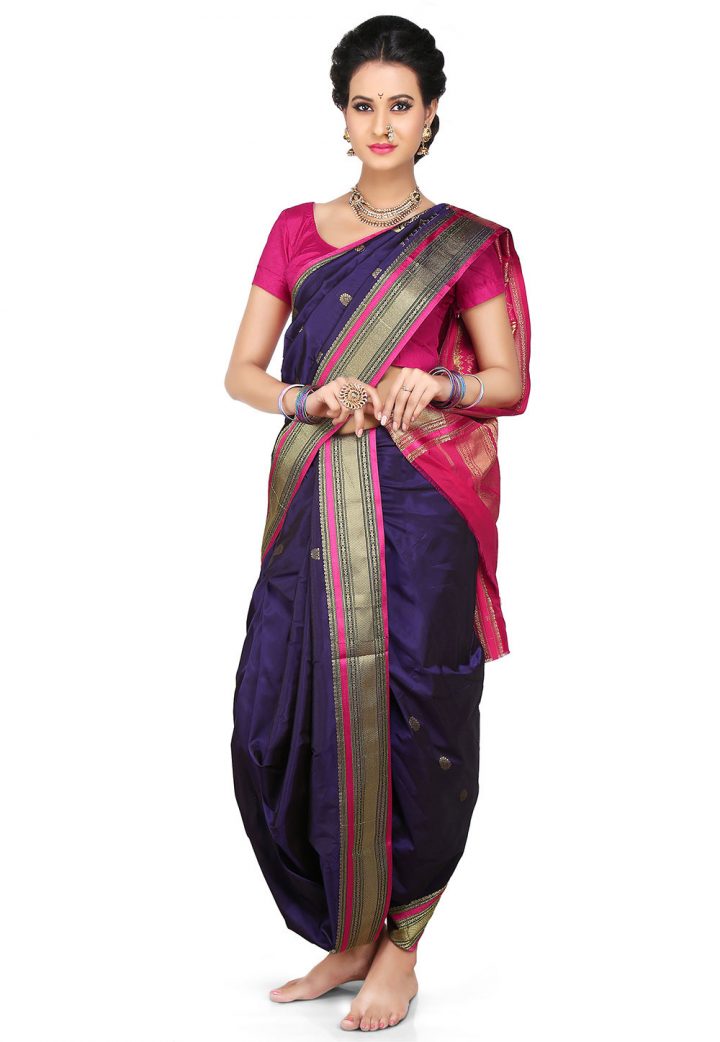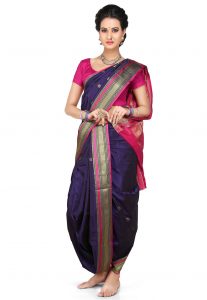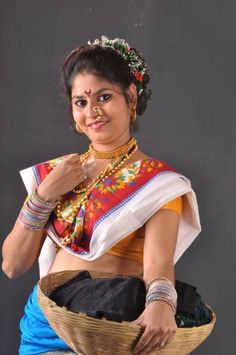
Nauvari Saree
Nauvari (also known as Nav Vari, Nauvaree, Kasta Sari, Kacha, Sakachcha, Lugade) is a nine yards saree worn by the Marathi women or women of Maharashtra. The name ‘Nauvari’ originated from the saree’s length of nine yards. The style of drape for Nauvari has evolved drastically from the traditional style to the modern-age cult and is draped in such a way that it gives a trouser-dress like an appearance, while the sari is tucked at the back. Nauvari sarees usually come in cotton and is worn without a Petticoat, majorly by the Maharashtrian Brahmin women community.
Origin & History
Historically, the women of the Maratha Empire showcased their abilities and caliber by assisting their fellow male warriors during the times of war. Hence, in order to accomplish their mission and yet maintain their comfort of physical movement during the wars, these Marathi women invented this Maharashtrian style of drape.
Sources of Inspiration
The Nauvari saree drives home, an essential truth that a woman, a motherly figure who is usually known as the home keeper can also be the protector of humankind when needed.
Different Drapes of Nauvari Sarees
Traditional Nauvari
The traditional style of drape inspired from the warrior Marathi women is worn without a petticoat. The drape comprises following steps:
- Center of the sari is neatly placed at the back of the waist.
- Ends of the saree are tied in the front, and then the two ends are wrapped around the legs, giving a trouser-like look.
- The decorative ends of the saree are then draped over the shoulder and the upper body.
The draping of this sari does not end here and moves down south to Goa- the land of fishermen and beaches. The traditional clothing of the fisher-women of Goa is an innovation to the Nauvari Sari – Pano Bhaju’. The women wear this in bright and vibrant colors and team it up with Vakal which is a string of beads with leaf loincloths worn around the neck.
Koli Drape
The Koli community comprises people who migrated from Rajasthan, Himachal Pradesh, Gujarat, Maharashtra, Uttar Pradesh and Haryana, to the state of Maharashtra. The women of this community wear Nauvari in two pieces. The Koli drape involves the following steps:
- Nauvari is cut into two pieces.
- One piece is tied around the waist.
- The second piece is tucked at the upper part of the body, and pulled over the head via the left shoulder, to give a Marathi look.
Wearing the Attire
The Nauvari saree is usually worn by the elderly Marathi women and the Maharashtrian Brahmin women. With rich culture and royal elegance of the Marathi women, Nauvari is usually accessorized with traditional gold jewelry and gajra in the hair.
A strong desire to wear the Nauvari sari, though quite a difficult task to drape one, the Nauvari went through an innovating concept of ‘Readymade/ Pre-Stitched Nauvari Saree.’
The uniqueness to this feature is that it is easy to wear, attractive looking and gives a very comfortable feeling, unlike the original draping. This innovation has brought it a global appeal and has made it easily accessible by all. It is made in such a way that it fits one’s size and no one ever realizes that it is actually a stitched sari
Evolution of Nauvari Sarees
Over the years, the Nauvari saree, Pano bhaju and the vakal have sustained their grandeur in spite of the changing fashion trends and culture. The Nauvari Sarees have seen a change from Cotton textiles to Silks. The saris have also seen a change in the color and the embroidery; from shades of blue and green to bright colors of pink, yellow, red, and sometimes shades of pastel grey, lavender and gold gives it the summer look and are more in sync with the trendy modern day style.
The embroidery has seen a sudden soberness and is restricted to limited sections of the cloth. The modern pre-formed sari, the Trench-Kurta, a lehenga teamed with a rather stimulating jeweled neck piece and a blouse, inventive and chic fringes or trimmings as accents, a sensual lungi skirt encompass the inspirational take on this creative ensemble.
The embroidery has seen a sudden soberness and is restricted to limited sections of the cloth. The modern pre-formed sari, the Trench-Kurta, a lehenga teamed with a rather stimulating jeweled neck piece and a blouse, inventive and chic fringes or trimmings as accents, a sensual lungi skirt encompass the inspirational take on this creative ensemble.
The embroidery has seen a sudden soberness and is restricted to limited sections of the cloth. The modern pre-formed sari, the Trench-Kurta, a lehenga teamed with a rather stimulating jeweled neck piece and a blouse, inventive and chic fringes or trimmings as accents, a sensual lungi skirt encompass the inspirational take on this creative ensemble.
Global Appeal
Designers like Julie Bendkhale of Zuilee, Vaishali Shandangule, Nachiket Barve have made strong fashion statements for Indian fashion on the ramp and their work is strongly influenced by the culture and traditional costumes of the country, including the exquisite and unique Nauvari sarees.
Changing the traditional textile from cotton fabric to silk in these saris has brought in it a royal look. For the tourists it is a must have a souvenir from the country. Several Indian actresses have adorned this nauvari saree at international events and have acclaimed applauds.
Interesting Facts and Comparisons
1. The Nauvari saree is also referred to as Kasta Sari, Kacha, Sakachcha, and Lugada.
2. Nauvari sarees are extremely popular in Bollywood and recently actress Vidya Balan donned this saree in one of her song sequences in the movie ‘Ferrari ki Sawari’.
3. The Nauvari saree is also seen as a rather provocative style of saree since it is different than the traditional style.
4. It is worn in most of the Maharashtrian or Marathi dance forms.
References
Categories: Attires, Clothing Styles & Drapes


